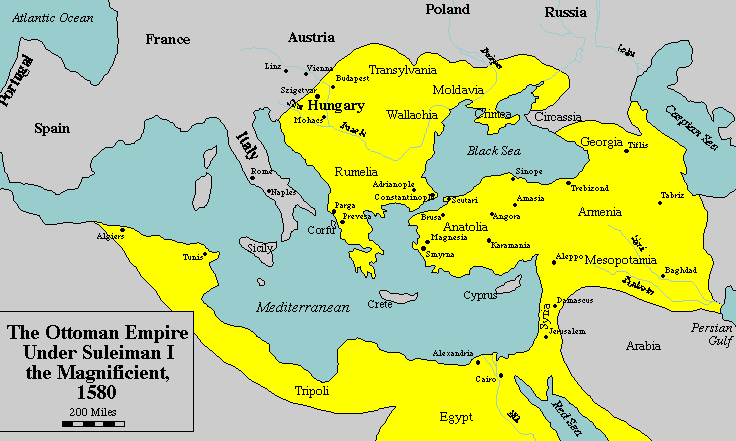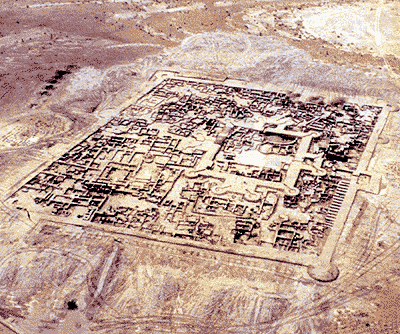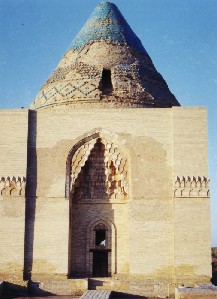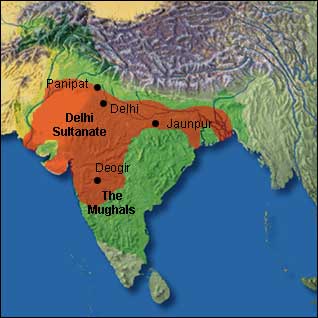The Ottoman State to 1481: the Age of Expansion
Topic: Turkmen History
The first period of Ottoman history was characterized by almost continuous territorial expansion, during which Ottoman dominion spread out from a small northwestern Anatolian principality to cover most of southeastern Europe and Anatolia. The political, economic, and social institutions of the classical Islamic empires were amalgamated with those inherited from Byzantium and the great Turkish empires of Central Asia and were reestablished in new forms that were to characterize the area into modern times.
Origins and expansion of the Ottoman state, c. 1300-1402 In their initial stages of expansion, the Ottomans were leaders of the Turkish warriors for the faith of Islam, known as ghazis, who fought against the shrinking Christian Byzantine state. The ancestors of Osman I, the founder of the dynasty, were members of the Kay tribe who had entered Anatolia along with a mass of Turkmen Oguz nomads. These nomads, fleeing from the Mongols of Genghis Khan, overwhelmed Byzantium after the Battle of Manzikert (1071) and occupied eastern and central Anatolia during the 12th century. The ghazis fought against the Byzantines and then the Mongols, who invaded Anatolia following the establishment of the Il-Khanid (Ilhanid) empire in Iran and Mesopotamia in the last half of the 13th century. With the disintegration of Seljuq power and its replacement by Mongol suzerainty, enforced by direct military occupation of much of eastern Anatolia, independent Turkmen principalities--one of which was led by Osman--emerged in the remainder of Anatolia.
Following the Mongol defeat of the Seljuq army in 1293, Osman emerged as prince (bey) of the border principality that took over Byzantine Bithynia in northwestern Anatolia around Bursa, commanding the ghazis against the Byzantines in that area. Hemmed in on the east by the more powerful Turkmen principality of Germiyan, Osman and his immediate successors concentrated their attacks on Byzantine territories bordering the Bosporus and the Sea of Marmara to the west. The Ottomans, left as the major Muslim rivals of Byzantium, attracted masses of nomads and urban unemployed who were roaming through the Middle East searching for means to gain their livelihoods and seeking to fulfill their religious desire to expand the territory of Islam. The Ottomans were able to take advantage of the decay of the Byzantine frontier defense system and the rise of economic, religious, and social discontent in the Byzantine Empire and, beginning under Osman and continuing under his successors Orhan (Orkhan, ruled 1324-60) and Murad I (1360-89), took over Byzantine territories, first in western Anatolia and then in southeastern Europe. It was only under Bayezid I (1389-1402) that the wealth and power gained by this initial expansion were used to assimilate the Anatolian Turkish principalities to the east.
By 1300 Osman ruled an area in Anatolia stretching from Eskisehir (Dorylaeum) to the plains of Iznik (Nicaea), having defeated several organized Byzantine efforts to curb his expansion. Byzantine attempts to secure Il-Khanid support against the Ottomans from the east were unsuccessful, and the Byzantine emperor's use of mercenary troops from western Europe caused more damage to his own territory than to that of the Turks. The Ottomans lacked effective siege equipment, however, and were unable to take the major cities of Bithynia. Nor could they move against their increasingly powerful Turkmen neighbours Aydn and Karas, which had taken over Byzantine territory in southwestern Anatolia. Orhan's capture of Bursa in 1324 (some sources date this event to 1326) provided the first means for developing the administrative, economic, and military power necessary to make the principality into a real state and to create an army. Orhan began the military policy, expanded by his successors, of employing Christian mercenary troops, thus lessening his dependence on the nomads.
Orhan soon was able to capture the remaining Byzantine towns in northwestern Anatolia: Iznik (1331), Izmit (1337), and Iskandar (1338). He then moved against his major Turkmen neighbours to the south. Taking advantage of internal conflicts, Orhan annexed Karas in 1345 and gained control of the area between the Gulf of Edremit and Kapdag (Cyzicus), reaching the Sea of Marmara. He thus put himself in a position to end the lucrative monopoly enjoyed by the city of Aydn, that of providing mercenary troops to competing Byzantine factions in Thrace and at Constantinople. The expansion also enabled the Ottomans to replace Aydn as the principal ally of the Byzantine emperor John VI Cantacuzenus. The consequent entry of Ottoman troops into Europe gave them a direct opportunity to see the possibilities for conquest offered by Byzantine decadence. The collapse of Aydn following the death of its ruler, Umur Bey, left the Ottomans alone as the leaders of the ghazis against the Byzantines. Orhan helped Cantacuzenus take the throne of Byzantium from John V Palaeologus and as a reward secured the right to ravage Thrace and to marry the emperor's daughter Theodora. Ottoman raiding parties began to move regularly through Gallipoli into Thrace. Huge quantities of captured booty strengthened Ottoman power and attracted thousands from the uprooted Turkmen masses of Anatolia into Ottoman service. Starting in 1354, Orhan's son Suleyman transformed Gallipoli, a peninsula on the European side of the Dardanelles, into a permanent base for expansion into Europe and refused to leave, despite the protests of Cantacuzenus and others. From Gallipoli his bands moved up the Maritsa River into southeastern Europe, raiding as far as Adrianople. Cantacuzenus soon fell from power, at least partially because of his cooperation with the Turks, and Europe began to be aware of the extent of the Turkish danger.
Orhan's son Murad I was the first Ottoman emperor to use Gallipoli for permanent conquests in Europe. Constantinople itself was bypassed, despite the weakness and disorganization of its defenders, because its thick walls and well-placed defenses remained too strong for the nomadic Ottoman army, which continued to lack siege equipment. Murad's initial conquests extended northward into Thrace, culminating with the capture in 1361 of Adrianople, the second city of the Byzantine Empire. Renamed Edirne, the city became the new Ottoman capital, providing the Ottomans with a centre for the administrative and military control of Thrace. As the main fortress between Constantinople and the Danube, it controlled the principal invasion road through the Balkan Mountains, assured Ottoman retention of their European conquests, and facilitated further expansion to the north. Murad then moved through the Maritsa River valley and captured Philippopolis (Filibe; modern Plovdiv) in 1363. Control of the main sources of Constantinople's grain and tax revenues enabled him to force the Byzantine emperor to accept Ottoman suzerainty. The death of the Serbian emperor Stefan Dusan in 1355 left his successors too divided and weak to defeat the Ottomans, despite an alliance with Louis I of Hungary and Tsar Shishman of Bulgaria in the first European crusade against the Ottomans. The Byzantine emperor John V tried to mobilize European assistance by uniting the churches of Constantinople and Rome, but this effort only further divided Byzantium without assuring any concrete help from the West. Murad was thus able in 1371 to rout the allies at Chernomen on the Maritsa, increasing his own confidence and demoralizing his smaller enemies, who rapidly accepted his suzerainty without further resistance.
Murad next incorporated into the rapidly expanding empire many European vassals. He retained local native rulers, who in return accepted his suzerainty, paid annual tributes, and provided contingents for his army when required. This policy enabled the Ottomans generally to avoid local resistance by assuring rulers and subjects that their lives, properties, traditions, and positions would be preserved if they peacefully accepted Ottoman rule. It also enabled the Ottomans to govern the newly conquered areas without building up a vast administrative system of their own or maintaining substantial occupation garrisons.
Moving rapidly to consolidate his empire south of the Danube, Murad captured Macedonia (1371), central Bulgaria (including Monastir [1382], Sofia [1385], and Nis [1386]), and Serbia, all culminating in the climactic defeat of the Balkan allies at the Battle of Kosovo in 1389. South of the Danube only Walachia, Bosnia, Albania, Greece, and the Serbian fort of Belgrade remained outside Ottoman rule, and to the north Hungary alone was in a position to resist further Muslim advances.
Murad was killed during the Battle of Kosovo. His son and successor, Bayezid I (1389-1402), was unable to take advantage of his father's victory to achieve further European conquest; in fact, he was compelled to restore the defeated vassals and return to Anatolia. This return was precipitated by the rising threat of the Turkmen principality of Karaman, created on the ruins of the Seljuq empire of Anatolia with its capital at Konya. Bayezid's predecessors had avoided forceful annexation of Turkmen territory in order to concentrate on Europe. They had, however, expanded peacefully through marriage alliances and the purchase of territories. The acquisition of territory in central Anatolia from the emirates of Hamid and Germiyan had brought the Ottomans into direct contact with Karaman for the first time. Murad had been compelled to take some military action to prevent it from occupying his newly acquired Anatolian territories but then had turned back to Europe, leaving the unsolved problem to his successor son.
Karaman willingly cooperated with Serbia in inciting opposition to Ottoman rule among Murad's vassals in both Europe and Anatolia. This opposition strengthened the Balkan Union that was routed by the Ottomans at Kosovo and stimulated a general revolt in Anatolia that Bayezid was forced to meet by an open attack as soon as he was able. By 1390 Bayezid had overwhelmed and annexed all the remaining Turkmen principalities in western Anatolia. He attacked and defeated Karaman in 1391, annexed several Turkmen states in eastern Anatolia, and was preparing to complete his conquest in the area when he was forced to turn back to Europe to deal with a revolt of some of his Balkan vassals, encouraged and assisted by Hungary and Byzantium. Bayezid quickly smashed the rebels (1390-93), occupied Bulgaria and installed direct Ottoman administration for the first time, and besieged Constantinople. In response, Hungary organized a major European crusade against the Ottomans. The effort was beaten back by Bayezid at Nicopolis (Nigbolu) on the Danube in 1396. Europe was terrorized and Ottoman rule south of the Danube was assured; Bayezid's prestige in the Islamic world was so enhanced that he was given the title of sultan by the shadow 'Abbasid caliph of Cairo, despite the opposition of the caliph's Mamluk masters (the rulers of Egypt, Syria, and the holy cities of Mecca and Medina), who wanted to retain the title only for themselves.
Turning back to Anatolia to complete the conquests aborted by his move against the crusaders, Bayezid overran Karaman, the last Turkmen principality, in 1397. His advances, however, attracted the attention of Timur (Tamerlane), who had been building a powerful Tatar empire in Central Asia, Iran, Afghanistan, and Mesopotamia and whose invasion of India in 1398 had been halted by his fear of the rising Ottoman power on his western flank. Encouraged by several Turkmen princes who had fled to his court when their territories were taken by Bayezid, Timur decided to destroy Bayezid's empire before resuming his campaigns in India and thus invaded Anatolia. As Bayezid and Timur moved toward battle, the former's Turkmen vassals and Muslim followers deserted him because he had abandoned the old Ottoman ghazi tradition of advancing against the infidel. Left only with forces provided by his Christian vassals, Bayezid was decisively overwhelmed by Timur at the Battle of Ankara in 1402. Taken captive, he died within a year.
Encyclopaedia Britannica

Map from www.allaboutturkey.com
Posted by countryturkmenistan
at 1:56 PM
Updated: Tuesday, 12 July 2005 1:43 PM
 The excavations in Margiana will make reconsider views on the remote past of humankind and fully reveal a real picture of the remote past of the remarkable Turkmen land located in the centre of Asia, on the crossroads of the ancient caravan routes and modern transcontinental communication lines. The participants of the International Scientific Conference “Ancient Margiana – a New Centre of the World Civilisation” held in the Mary Velayat and that completed its work have come to such conclusion.
The excavations in Margiana will make reconsider views on the remote past of humankind and fully reveal a real picture of the remote past of the remarkable Turkmen land located in the centre of Asia, on the crossroads of the ancient caravan routes and modern transcontinental communication lines. The participants of the International Scientific Conference “Ancient Margiana – a New Centre of the World Civilisation” held in the Mary Velayat and that completed its work have come to such conclusion. 

 The Khwarezmid Empire (also known as the Khwarezmian Empire) was a Muslim state formed by Oghuz Turks in the 11th century in Khwarezmia that lasted until the Mongol invasion in 1220.
The Khwarezmid Empire (also known as the Khwarezmian Empire) was a Muslim state formed by Oghuz Turks in the 11th century in Khwarezmia that lasted until the Mongol invasion in 1220. In Great Captains Unveiled of 1927, B.H. Liddell Hart gave details of the Mongol campaign against Khwarezm which underscored his own philosophy of "the indirect approach," and highlighted many of the tactics used by Genghis which were to be subsequently included in the German blitzkrieg form of war, inspired in part by Liddell Hart's writings.
In Great Captains Unveiled of 1927, B.H. Liddell Hart gave details of the Mongol campaign against Khwarezm which underscored his own philosophy of "the indirect approach," and highlighted many of the tactics used by Genghis which were to be subsequently included in the German blitzkrieg form of war, inspired in part by Liddell Hart's writings. R.L.Hangloo (India)
R.L.Hangloo (India) 